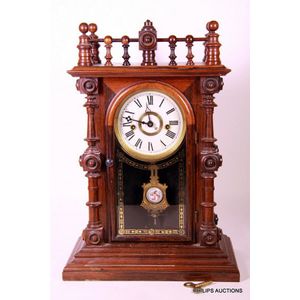E.N. Welch Rosewood Mantle Clock with Brass Pendulum
An E.N. Welch 'Gerster' rosewood mantle clock, later 19th century, American, with key and pendulum, the eight day architectural style clock having a dial with Roman numerals set within a glazed case with an ornamental brass and glass pendulum, the case with a gallery of turned spindles and finials, three quarter turned pillars to the case and raised on a stepped base; with maker's label verso, height 45 cm, width 31 cm, depth 16 cm
You must be a subscriber, and be logged in to view price and dealer details.
Subscribe Now to view actual auction price for this item
When you subscribe, you have the option of setting the currency in which to display prices to $Au, $US, $NZ or Stg.
This item has been sold, and the description, image and price are for reference purposes only.
- Finial - An architectural decoration, found on the upper parts of of an object. On furniture they are usually found on pediments, canopies and shelf supports. On smaller ceramic or silver items, such as spoons, they may decorate the top of the item itself, or the lid or cover where they provide a useful handle for removal.
Finials have a variety of shapes and forms. They may be urn-shaped, baluster shaped round or spiral, but usually taper into an upper point. Many real life shapes may also be used as finials, such as pineapples, berries, pinecones, buds, lotus and acorns. Sometimes animals such as a lion are depicted, or fish and dolphins. - Rosewood - A dense timber that varies in shade to very light brown to almost black. When rosewood is cut and sanded the colour of the timber will turn black, and after polishing and exposure to daylight, the surface will gradually lighten over time to light brown with black streaks.
The name comes from the odour emanating from the timber when it is planed, sanded or cut.
Rosewood was very popular for use in Victorian furniture in the second half of the 19th century, and at that time most of the rosewood was imported from Brazil. However it also grows in India and Indonesia.
It is used in the sold for chairs and table legs, but for carcase furniture such as side cabinets and bookcases, and for table tops it is always used as a veneer. - Verso - Verso is the "back" side of a sheet of paper, art work, coin or medal. The front side is "recto".
- Pendulum - The pendulum was discovered around 1602 by Galileo Galilei, and was adopted for time keeping by the Dutch mathematician and natural philosopher, Christiaan Huygens, who excelled in astronomy, physics, and horology.
The pendulum comprises a metal rod usually of brass or steel with a metal disk, known as a bob, at the end. The movement of the pendulum is driven by weights or a spring, and as a pendulum swings in a regular arc, it was found accuracy could be controlled to within a few seconds a week.
Timekeeping can be adjusted by changing the height of the bob on the rod, making the pendulum either swing slower or faster.
The disadvantage of the pendulum was that changes in temperature also changed the length of the pendulum, interfering with the accuracy of the clock, and so in the 18th century two types of mercurial pendulums were invented which countered the movement in the steel rod.
The pendulum was the world's most accurate timekeeping technology until the invention of the quartz clock, regulated by a quartz crystal, in 1927.
This item has been included into following indexes:
Visually similar items

Antique Ansonia mantle clock in carved timber case, 56 cm high
Sold by
in
for
You can display prices in $Au, $US, $NZ or Stg.

American wall clock, no key, has pendulum, approx 60 cm high, 32 cm wide
Sold by
in
for
You can display prices in $Au, $US, $NZ or Stg.

American Ingraham wood cased mantle clock, carved wood case and pediment. Key and pendulum available. Appears operational, however, untested. Height 64 cm
Sold by
in
for
You can display prices in $Au, $US, $NZ or Stg.

A continental walnut cased spring driven regulator wall clock. 123 cm high.
Sold by
in
for
You can display prices in $Au, $US, $NZ or Stg.
